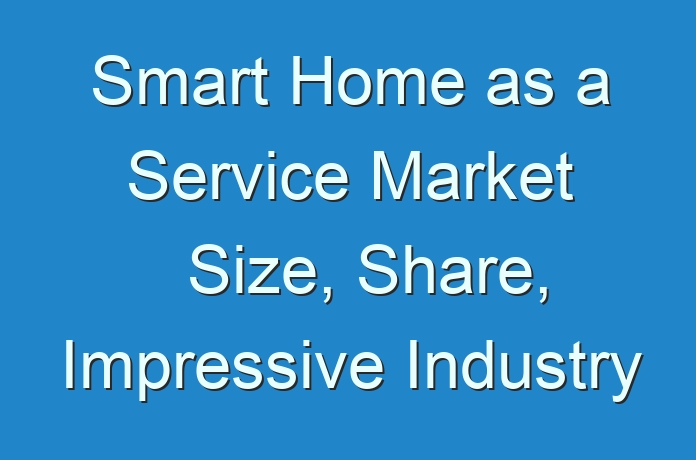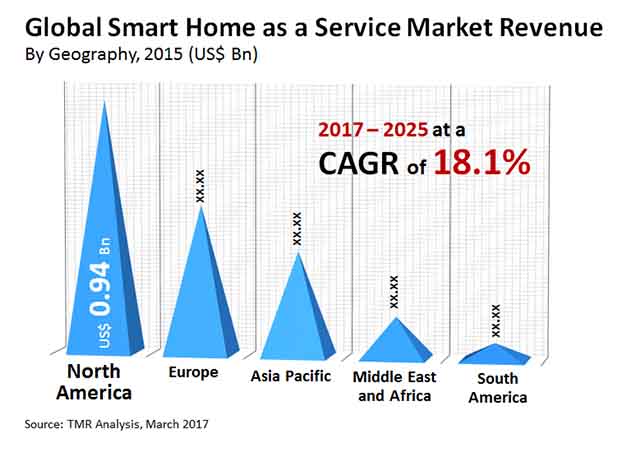
Global Smart Home as a Service Market: Snapshot
Besides convenience, a chief factor fuelling the uptake of smart home products is their assistance in energy management. Smart home as a service solutions not only enable users manage entertainment and other electronic appliances remotely, they also help customers keep a tab on the energy consumption. In addition, the rising demand for advanced security and surveillance has created an environment supporting strong growth of the global smart home as a service market. Because of opportunities it exhibits, the smart home as a service market has been attracting new players. While this pose threat to the existing companies, it also paves way for innovations and upgrade of existing technologies.
On the flip side, the high cost of smart home products is inhibiting the market’s trajectory to an extent. Furthermore, privacy concerns and possibility of misusing the technology have made customers skeptical of deploying smart home solutions. Nevertheless, the advent of novel connectivity standards is expected to help the market players mitigate the aforementioned concerns in the coming years.
The global smart home as a service market is forecast to reach US$10.9 bn by the end of 2025. In 2016, the market’s valuation stood at US$2.46 bn. If these figures hold true, the global smart home as a service market will exhibit an impressive CAGR of 18.1% between 2017 and 2025.
The demand within the global smart home as a service market is set to increase in the years to follow. Advancements in the energy sector have boded well for the growth of this market. The development of urban centers across all major regions of the world have played a crucial part in popularizing smart homes. The utility and ease offered by the components of smart homes have further caused an uptick in demand across the global market. Several people have become sensitive towards their energy consumption patterns, prompting them to install smart and energy-efficient technologies in their household. In light of these factors, it is safe to predict that the global smart home as a service market would grow at a stupendous pace.
Planning to lay down future strategy? Perfect your plan with our report sample here https://www.transparencymarketresearch.com/sample/sample.php?flag=S&rep_id=21419
- The development of smart grids across town centers and cities has facilitated the development of smart residential and commercial buildings. There is increasing demand for smart technologies across the industrial sector as well, and this trend has played an underhanded role in the growth of the global smart home as a service market. The focus of the energy industry on inducing economical and sustainable standards in human living has given a thrust to market growth.
- Integration of automation technologies such as artificial intelligence and machine learning in the smart home framework has created new pathways for growth across the global market. HVAC systems have gained popularity across the commercial and residential sector, creating renewed demand for smart home as a service. Several new electronic companies are providing integration services for smart home development. This is also a resilient dynamic of growth operating in the global smart home as a service market.
There is little contention about the inflow of fresh revenues into the global smart home as a service market as new and intelligent technologies make their way across the marketplace.
Advancements in the domain of cyber security have created new inlets for growth across the global supervisory control and data acquisition (SCADA) market. The unprecedented demand for improved hardware and software architecture across organizations and industrial units has generated increased demand within the global market. The domain of cyber security has expanded its roots to all other industries, reflecting the seriousness of the masses to develop novel cyber practices. Several companies have strengthened their holds over their cyber security architecture in order to stay relevant in times of entropy and change. As the hardware architecture of companies becomes more sophisticated, the global SCADA market would tread along a lucrative pathway.
- Data breaches and cyberattacks have caused the industrial sector to elevate its gradient of technical learning. This has also created a large playfield of opportunities for the vendors operating in the global supervisory control and data acquisition market. Moreover, the collaboration of SCADA systems with PLCs has further enhanced the gradient of security across industries and companies. The quest of the industrial sector to go seamless with data security has also played to the advantage of the global market.
- The entire network of computers and other relevant hardware has become more advanced in recent years. This factor has directly contributed towards the growth of the global supervisory control and data acquisition market. Moreover, the relevance of protecting confidential data across mission-critical industries has also played to the advantage of the vendors operating in the global market. The presence of dedicated cyber security teams across several companies has also enabled the inflow of fresh revenues into the global supervisory control and data acquisition market.
Looking for exclusive market insights from business experts? Request a Custom Report here https://www.transparencymarketresearch.com/sample/sample.php?flag=S&rep_id=4411
The security industry is at the forefront of growth within the global SCADA market, and is expected to dig out new technologies and systems that use supervisory control.

Integrated Services to Continue Witnessing High Demand
On the basis of service, the global smart home as a service market is bifurcated into managed and integrated. The integrated service segment is anticipated to contribute major share in the global smart home as a service market. It is expected to hold nearly 63.6% of the market by the end of 2017. With the increasing demand and adoption of integrated services, the integrated services segment is likely to witness steady growth and thus remain dominant throughout the forecast period. The managed service segment is expected to hold a comparatively smaller share of the global smart home as a service market.
On the basis of solution, the global smart home as a service market is segmented into security and access, lighting and window, audio-visual and entertainment, energy management and climate and integrated solutions. Of these, the integrated solutions segment is expected to hold the major share of the smart home as a service market. Security and access solution segment will emerge as the second-lead in terms of market share. Audio-visual and entertainment is projected to beat other segments in terms of growth pace. The segment is forecast to exhibit a CAGR of 19.67% during the period from 2017 to 2025. This growth is primarily ascribable to increased demand for streaming services and online content.
Presence of Leading Players in North America helps it attain Dominance
The global smart home as a service market is expected to be led by North America. The region’s share in the market is expected to reach over 45% by the end of 2017, with the U.S. at the fore. Besides being an early adopted of advanced technologies, the North America market is gaining from the presence of several leading players in the region. Europe in 2016, has emerged as the second-leading market for smart home as a service in the world. In the region, France, Germany, and the U.K., have emerged as the most lucrative pockets. Moreover, Europe’s local industry exhibits a strong growth and overall consumers are aware of the latest technologies. These factors are expected to act in favor of the market in Europe.
Through the course of the forecast period, Asia Pacific is forecast to exhibit highly lucrative opportunities. The market players are likely to capitalize on the rising demand from China, Japan, Australia, and South East Asian countries.
The key players profiled in the global smart home as a service market include AT&T Inc., CenturyLink, Inc., Charter Communications (TWC), Comcast Corporation, Frontpoint Security Solutions, Ingersoll-Rand plc (Nexia), Johnson Controls, Inc., Protection One Alarm Monitoring, Inc., The ADT Corporation and Vivint, Inc.





